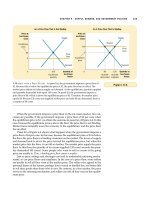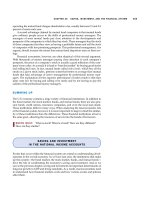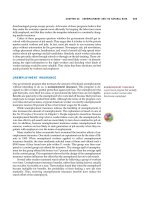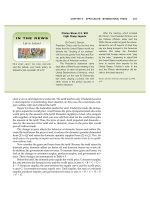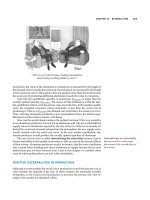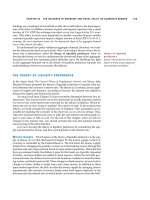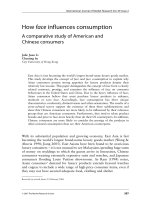How Economics Shapes Science doc
Bạn đang xem bản rút gọn của tài liệu. Xem và tải ngay bản đầy đủ của tài liệu tại đây (1.56 MB, 384 trang )
How Economics Shapes Science
HOW ECONOMICS
SHAPES SCIENCE
PAULA STEPHAN
HARVARD UNIVERSITY PRESS
Cambridge, Massachusetts
London, En gland
2012
Copyright © 2012 by the President and Fellows
of Harvard College
All rights reserved
Printed in the United States of America
Library of Congress Cataloging- in- Publication Data
Stephan, Paula E.
How economics shapes science / Paula Stephan.
p. cm.
Includes bibliographical references and index.
ISBN 978- 0- 674- 04971- 0 (alk. paper)
1. Research— Economic aspects. 2. Science and state. I. Title.
HC79.R4S74 2012
500—dc23 2011013433
For Bill, always for Bill
List of Figures and Tables ix
Preface xi
List of Abbreviations xiii
1 What Does Economics Have to Do with Science? 1
2 Puzzles and Priority 16
3 Money 35
4 The Production of Research:
People and Patterns of Collaboration
61
5 The Production of Research:
Equipment and Materials
82
6 Funding for Research 111
7 The Market for Scientists and Engineers 151
8 The Foreign Born 183
9 The Relationship of Science to Economic Growth 203
10 Can We Do Better? 228
Appendix 243
Notes 247
References 307
Ac know ledg ments 349
Index 353
Contents
Figures
4.1 Cumulative percentage of institutions adopting BITNET,
by tier
77
4.2 Cumulative percentage of institutions adopting a domain
name, by tier
77
5.1 Net assignable square feet for research by eld,
at academic institutions, 1988– 2007
107
6.1 Research and development expenditures at universities
and colleges by source, 1953– 2009
115
6.2 Share of federal university research and development
obligations by eld, 1973– 2009
129
6.3 National Institutes of Health competing R01 equivalent
awardees by age, 1995– 2010
144
7.1 Science and engineering PhDs by citizenship and gender,
1966– 2008
153
7.2 Mean earnings of PhDs relative to mean earnings of
terminal baccalaureate recipients, by eld, 1973– 2006,
early career and late career
155
7.3 Job position by eld, ve- and six-year cohort, 1973– 2006 160
7.4 Number of science and engineering postdocs by eld,
1980– 2008
167
8.1 Science and engineering degrees by citizenship status,
1966– 2008
187
Figures and Tables
Figures and Tables
p
x
8.2 Number of science and engineering postdocs working in
academe, 1980– 2008, by citizenship status
193
9.1 Percentage of PhDs working in industry by eld, fth and
sixth year cohort, 1973– 2006
220
Tables
3.1 Mean and high academic salaries in dollars, selected
disciplines by rank, 2008, public research universities
38
3.2 Mean and 90th percentile academic salaries, selected
disciplines by rank, 2006, public and private
PhD- granting institutions
40
3.3 In e qual ity of salaries of faculty working at
doctorate- granting institutions, 1973– 2006, selected
elds: Gini coef cient
41
4.1 Coauthorship patterns at U.S. research institutions
by eld, 1981 and 1999
73
6.1 Funding for research in higher education by country,
source, and year, percentage
124
7.1 Projected lifetime earnings of MBA versus PhD
in biological sciences holding a position a research
university
157
8.1 Percentage of foreign- born faculty at U.S. universities
and colleges by eld and year
186
T
that explores what economics has to do with science.
The book also explores how science affects the economy, especially
economic growth. Because much of public research occurs at universi-
tiesand medical schools, especially in the United States, much of the
book’s focus is on how research is conducted and supported at universi-
ties. It isalso about the consequences for universities of having the re-
search enterprise— at least in the United States— so fully embedded in the
university.
This is not to say that economics has a monopoly when it comes to fac-
tors that affect science or in providing a lens for examining science. Other
disciplines— and their foci— contribute considerably to the study of science.
Sociology, for example, contributes a great deal to the understanding of how
science is or ga nized and the reward structure of science. It is also not to say
that science is the only factor that contributes to economic growth. Politics
and values, for example, clearly play important roles.
Despite the title, the book draws on research and insights from several
disciplines. Indeed, one of the factors that led me to study science was the
opportunity to indulge my interest in and penchant for reading outside
my— sometimes overly narrow— discipline of economics.
Some of the discussion in the book is highly descriptive, summarizing
what is known about the various players and factors that in uence research
behavior and outcomes. This descriptive nature is by design. Throughout
Preface
Preface
p
xii
my thirty- plus years of studying science, I have been amazed at the number
of people who venture to write about science and science policy without
understanding the environment in which research takes place. One of my
goals in writing this book is to lay out the scienti c landscape in what I
hope to be a somewhat engaging manner, so that those who wish to con-
tinue the study of the economics of science (and I am happy to say there
are a growing number) can approach it with a more solid footing. I also
hope to offer, from time to time, questions that warrant further research.
I do not mean by this that I see myself as the rst to examine these issues,
and I certainly don’t see myself as the most pro cient. Far from it: my
work— and that of other scholars in the eld— owes an enormous debt to
the luminaries who began the eld a generation (or half a generation) be-
fore I began doing research in the area. They include Kenneth Arrow, Paul
David, Zvi Griliches, Robert K. Merton, Richard Nelson, and Nathan
Rosenberg.
But I did not only— or primarily— write the book for my peers or their
students. I also wrote it for the considerable community that works at public
research institutions, be they in the United States, China, Eu rope, or Japan. I
also wrote it for policy makers, as well as for members of the general public
who share an interest in the workings of public institutions and the study of
science. It is my hope that a greater understanding of how economics shapes
science can lead to more effective science policy and a better use of resources
in the research enterprise.
AAMC Associations of American Medical Colleges
AAU American Association of Universities
ANR L’Agence nationale de la recherche (France)
APS Advanced Photon Source, Argonne National Laboratory
ARRA American Recovery and Reinvestment Act
AUTM Association of University Technology Managers
BLS Bureau of Labor Statistics
CERN Eu ro pe an Or ga ni za tion for Nuclear Research
CIS Community Innovation Surveys (Eu rope)
CMS Compact Muon Selanoid (at CERN)
CPS Current Population Survey
CNRS Centre national de la recherche scienti que (National Center for
Scienti c Research, France)
DARPA Defense Advanced Research Projects Agency (U.S.)
DGF Direct government funds
DOD Department of Defense (U.S.)
DOE Department of Energy (U.S.)
E-ELT European Extremely Large Telescope
ERC Eu ro pe an Research Council
FIRB Fund for Investing in Fundamental Research (Italy)
GMT Giant Magellan Telescope
GRE Graduate Record Examination
GUF General university funds
H-1B visa A nonimmigrant visa that allows U.S. employers to hire
noncitizens on a temporary basis in occupations requiring
specialized knowledge
Abbreviations
Abbreviations
p
xiv
hESC The human embryonic stem cell policy implemented under
President George W. Bush in 2001
HGP Human Genome Project
HHMI Howard Hughes Medical Institute
ITER International Thermonuclear Experimental Reactor
LHC Large Hadron Collider (at CERN)
MOU Memorandum of Understanding
NASA National Aeronautics and Space Administration
NIGMS National Institutes of General Medical Science
NIH National Institutes of Health
NIST National Institute of Standards and Technology
NRSA National Research Ser vice Awards
NSCG National Survey of College Graduates (Census administered;
overseen by NSF)
NSF National Science Foundation
OECD Or ga ni za tion for Economic Co- operation and Development
OWL Overwhelmingly Large Telescope
PSI Protein Structure Initiative (NIH)
R&D Research and development
RAE Research Assessment Exercise (U.K.)
REF Research Excellence Framework (to replace the Research
Assessment Exercise, U.K.)
R01 Research project grant awarded by NIH, it is the agency’s oldest
grant mechanism used by the NIH to support research; generally
investigator initiated.
S&E Science and engineering
SDR Survey of Doctorate Recipients (NSF- collected data)
SDSS Sloan Digital Sky Survey
SED Survey of Earned Doctorates (NSF- collected data)
SEPPS National S&E PhD & Postdoc Survey
SER- CAT Southeast Regional Collaborative Access Team
SKA Square Kilometer Array
SMSA Standard Metropolitan Statistical Area
Study Section Scienti c review groups at NIH, primarily made up of
nongovernment experts
TMT 30- meter telescope
TTO Technology Transfer Of ce
How Economics Shapes Science
T
about how economics shapes science as practiced at
public research organizations. In the United States these are primarily
universities and medical schools. But in Eu rope and Asia a considerable
amount of public research is conducted at research institutes. The book’s
focus re ects the strong role that public research organizations play in
creating knowledge. In the United States, for example, approximately 75
percent of all articles published in scienti c journals are written by scien-
tists and engineers working at universities and medical schools.
1
Of equal
importance, almost 60 percent of basic research is conducted at universi-
ties and medical schools.
2
What does economics have to do with science? Plenty, it turns out.
Economics, after all, is the study of incentives and costs, of how scarce
resources are allocated across competing wants and needs. Science costs
money and incentives play a key role in science. At the extreme end of the
cost spectrum is the Large Hadron Collider (LHC), which came on line
(for the second time) in the fall of 2009 and cost approximately $8 billion
(U.S.).
3
But there are numerous other examples. The personnel costs of a
typical university lab with eight researchers is about $350,000 after fringe
bene ts but before taking into account the cost of the principal investiga-
tor’s time or indirect costs.
4
Public research organizations routinely spend
large sums of money building and maintaining research facilities and large
sums of money on start- up packages for faculty hired to work in the new
What Does Economics
Have To Do with Science?
What Does Economics Have To Do with Science?
p
2
facilities. In recent years, these packages have become suf ciently large
that a university routinely spends four to ve times as much on the pack-
age as on the faculty member’s annual salary.
5
Even mice, the ubiquitous
research animal, can cost a substantial amount to buy and keep. Custom-
made mice, designed with a predisposition to a speci c disease or problem,
such as diabetes, Alzheimer’s disease, or obesity, can cost in the neighbor-
hood of $3,500. The daily cost of keeping a mouse is around $0.18. Sounds
cheap— until one realizes that some researchers keep a suf cient number
of animals that the annual bud get for mouse upkeep can be in excess of
$200,000.
6
The amount of money spent on scienti c research in the public sector is
substantial. The United States spends between 0.3 and 0.4 percent of its
gross domestic product (GDP) on research and development at universities
and medical schools. This represented almost $55 billion dollars in 2009
or approximately $170 per person.
7
While most other countries spend a
smaller percent of GDP, several countries, including Sweden, Finland, Den-
mark, and Canada, spend a considerably higher percentage of their GDP
on research and development at universities and medical schools.
8
Costs
Costs affect the way research is conducted. Costs were a major factor in
Eu rope’s decision to settle for building the Exceedingly Large Telescope
(E-ELT) rather than the Overwhelmingly Large Telescope (OWL)— with its
much larger mirror— as originally planned.
9
Costs can derail large projects
or at best delay them. Original plans called for the multi- billion- euro fusion
reactor ITER to begin operation in 2016. Now the earliest that ITER can
become operational is in 2018— and if it does become operational at that
time, it will be a stripped- down version; additional components will be
needed for power- producing plasmas.
10
Along the way, the costs of con-
structing ITER keep rising. New cost calculations made public in the spring
of 2010, for example, suggest that Eu rope’s contribution will be 2.7 times
greater than the amount originally estimated; that of the United States will
be about 2.2 times greater.
11
Costs play a role in determining whether researchers work with male
mice or female mice (females, it turns out, can be more expensive), whether
principal investigators staff their labs with postdoctoral fellows (postdocs)
or graduate students, and why faculty prefer to staff labs with “temporary”
workers, be they graduate students, postdocs, or staff scientists, rather than
with permanent staff. High electricity costs dictate that the LHC not run in
What Does Economics Have To Do with Science?
p
3
the winter but rather during the rest of the year when electricity is consid-
erably less expensive.
12
Costs are a major factor in determining what
equipment at a university will be “core” and shared across labs rather
than belonging to a speci c lab. Costs— and the desire to minimize risk—
have played a major role in the decision of universities to substitute non-
tenure- track faculty for tenure- track faculty.
Costs affect the pace of discovery. When the human genome project be-
gan in 1990, it cost more than $10.00 to sequence a base pair. Sequencing
costs fell rapidly, hitting less than a penny a base pair by 2007. That is now
ancient history: since then, new generations of sequencing technology have
been developed that have lowered the cost dramatically. Before this book
sees the light of day, it is possible that the Archon X Prize for Genomics will
be awarded to the rst group to “build a device and use it to sequence 100
human genomes within 10 days or less . . . at a recurring cost of no more
than $10,000 per genome.”
13
Incentives
Universities respond to incentives. In the early 2000s, universities went on
an unpre ce dented building spree, developing new research facilities in the
biomedical sciences. Within less than ve years, construction and renova-
tion costs for biomedical research facilities accelerated from $348 million
annually to $1.1 billion annually at U.S. medical schools. (All gures are
in 1990- adjusted dollars.)
14
The reason: the bud get for the National Insti-
tutes of Health, the major funder of research in the biomedical sciences,
doubled between 1998 and 2003, opening a panoply of what universities
perceived to be new opportunities to expand their research efforts and, in
the pro cess, enhance their reputation. It was not the rst time that U.S.
medical schools responded to nancial incentives. The substantial expan-
sion of medical colleges over the past 40 years is widely attributed to the
adoption of Medicare and Medicaid in 1965, which provided university
medical schools with a new source of revenue.
Scientists and engineers respond to incentives as well. Money, despite
statements to the contrary, is not unimportant. Actions speak louder than
words. Scientists routinely move to take more lucrative- paying positions.
A number of public universities have lost faculty in recent years because
private universities, especially before the nancial collapse of 2008, could
often offer much more lucrative packages than their public sisters. Indeed,
in the 2009– 2010 academic year, only one public institution (UCLA) was
among the top twenty research universities in terms of salaries paid to full
What Does Economics Have To Do with Science?
p
4
professors— and it held the 20th position, paying $43,000 less than top-
paying Harvard. Phones began to ring at Berkeley in 2009 soon after the
California system imposed a substantial pay cut on its faculty. Full profes-
sors at Berkeley already earned about 25 percent less than their peers at
Harvard and Columbia. Now they would earn even less.
15
Scientists respond to incentives in choosing where to submit articles for
publications. The number of articles submitted to the journal Science, for
example, is signi cantly related to whether the scientist’s home country
offers a bonus or other monetary reward for publishing in the journal.
16
In
some instances, the bonuses can be quite large— on the order of 20 to 30
percent of the scientist’s base salary.
Financial incentives encourage university faculty to start new companies
based on their research. In recent years, a number of scientists have made
substantial sums of money by forming start- up companies or by receiving
royalties from universities licensing patents on which they are an inventor.
David Sinclair, a Harvard professor and found er of Sirtris Pharmaceuti-
cals, received more than $3.4 million for the shares he held in Sirtris when
Glaxo acquired the company in 2008. Robert Tjian received millions in
2004 when Tularik, the company he cofounded when he was a faculty
member at the University of California– Berkeley, was sold to Amgen for
$1.3 billion. Stephen Hsu, a professor of physics at the University of Ore-
gon, received a substantial amount when Symantec paid $26 million in cash
in 2003 for one of two software companies he had founded. László Z. Bitó,
whose work led to the invention of the drug Xalantan for the treatment of
glaucoma, has earned several million a year from the patent that Colum-
bia University held on the drug. The patent is due to expire in 2011.
17
In
2005, three researchers at Emory University divided more than $200 mil-
lion when Emory sold its royalty interest in emtricitabine, used in the treat-
ment of human immunode ciency virus (HIV), to Gilead Sciences and Roy-
alty Pharma. Although rare, events such as these occur with suf cient
frequency that, on the campus of almost every research university in the
United States, two or three faculty members have become wealthy as a result
of their research.
Neither do scientists, especially highly productive scientists, receive a
pauper’s pay. Full professors at the top of their game employed at private
research universities in math earned an annualized salary of $180,000 a
year in 2006 in the United States. Comparably ranked full professors
atpublic universities earned $150,000. Those in the biological sciences
earned $277,700 at private research universities; those at public universi-
ties earned $200,000.
18
It is no wonder that the United States has been a
magnet for highly productive Eu ro pe an scientists. Not only has there been
What Does Economics Have To Do with Science?
p
5
a tradition of more support for investigator- initiated research in the United
States, but salaries are also signi cantly higher and are based, at least in
part, on productivity. By way of contrast, at many Eu ro pe an universities
and research institutes scientists are civil servants and receive the same
(relatively low) pay regardless of per for mance. In France, for example, a
professeur des universités with considerable se niority earns approximately
$70,000.
19
Relative salaries have an impact on who does science. The decline in the
propensity (and for many years the number) of U.S. citizens to choose a
career in science, particularly men, can be attributed in part to the low sala-
ries scientists and engineers earn relative to the salaries in other occupa-
tions. Many of the best and brightest from Harvard routinely have gone to
Wall Street. The $277,000 salary is not peanuts; neither is the $180,000
but these salaries come after years of training and hard work. Entry level
jobs on Wall Street for freshly minted bachelor’s degrees— especially before
the crash— paid two- thirds of what the PhD at the top of his game was
paid.
20
MBAs from a top program have the prospect of earning slightly
more than three times the faculty salary—$559,802, to be precise— after
they have been out 10 or more years and started their career in banking.
21
Increased availability of fellowships for study, as well as an increase in
the size of the fellowship, attracts more students into graduate programs.
The widespread availability of research assistantships for study in the
United States, and the possibility of working in the United States after
completing graduate school, have proved to be powerful incentives in lur-
ing the foreign born to come to the United States to train.
Not all incentives are monetary. Non- monetary incentives are important
to both faculty and institutions. Ask almost any scientist why they became
a scientist, and the answer will almost invariably be an interest in solving
puzzles. Most scientists derive considerable satisfaction from the “plea sure
of nding things out.” The enjoyment derived from puzzle solving is part
of the reward of doing science. But scientists are also motivated to do sci-
ence by an interest in recognition. Reputation matters in science. Reputa-
tion is built in science by being the rst to communicate a nding, thereby
establishing priority of discovery. A common way to mea sure the reputa-
tion of a scientist is to count the number of citations to an article or to the
entire body of the scientist’s work. The h- index, a citation- based method
for mea sur ing the impact of a scientist’s work, has gained considerable use
in recent years. Some scientists routinely include their h- index in their bio-
graphical sketches; others design webpages in which their h- index is promi-
nently displayed on the screen.
22
Departments have been known to use the
h- index to choose among job candidates when making hiring decisions.
What Does Economics Have To Do with Science?
p
6
The recognition that the scienti c community bestows on priority has
varied forms, depending on the importance the community attaches to the
discovery. At the very top of the list is eponymy, the practice of attaching
the scientist’s name to the discovery. By way of example, the Richter scale
is named for Charles Richter, who, along with Beno Gutenberg, devised
the scale while working at Caltech in 1935.
23
The Hubble telescope is
named for Edwin Hubble, the astronomer who discovered in 1929 that
the universe is expanding. Other examples of eponymy include Haley’s
comet, the Salk vaccine, Planck’s constant, and Hodgkin’s disease.
Recognition also comes in the form of prizes. Among these, the Nobel is
the best known. But hundreds of other prizes exist, and more are created
every year. The Kavli Prize, for example, with its $1 million purse in each of
three elds, was awarded for the rst time in the fall of 2008 by the King of
Norway.
24
It is not only scientists and engineers who seek reputation. Universities
strive to be highly rated, basing their position in the reputational hierarchy
on metrics such as faculty research productivity (mea sured by citation
counts or research dollars), number of Nobel laureates, or members of
national academies. Their pursuit of status is undoubtedly one reason that,
despite complaints that they routinely lose money on research grants, uni-
versities continue to urge (some would say pressure) faculty to bring in the
grants.
25
Knowledge as a Public Good
A reward structure that encourages scientists to share their discoveries in a
timely manner is highly functional. The reason: knowledge has character-
istics of what economists call a public good. It is nonexcludable and non-
rivalrous. The classic example in economics of a public good is the light-
house. It is nonexcludable: once built, anyone can use it. It is nonrivalrous:
an additional user does not diminish the amount of light available for
others. Parallels can be drawn with knowledge: once research ndings are
made public, it is dif cult to exclude others from using the knowledge. And
research ndings are not depleted when shared.
26
Economists have gone to considerable length to show that the market is
not well suited for producing goods with such characteristics.
27
The incen-
tives simply are not there. If one cannot limit access, it is dif cult to make
a pro t. Public goods invite free ridership. Consumers can use the good
without paying for it. Similar free ridership problems could exist for scien-
tists. Unlike the wine maker, whose customers must pay if they wish to
What Does Economics Have To Do with Science?
p
7
drink his wine, or the baseball team that can sell tickets to its games, the
researcher has no way of excluding others from using his research if he
makes it public through publication. He has no way of appropriating
the monetary bene ts. It is particularly dif cult to appropriate the bene ts
of basic research, which at best is years away from contributing to prod-
ucts the market may or may not value. The lack of monetary incentives
could lead to what economists refer to as “market failure,” with society
producing considerably less research than is socially desirable.
“Society, however, is more ingenious than the market.”
28
The priority
system has evolved in science to create a reward system that encourages
the production and sharing of knowledge. The very act of staking a claim
requires scientists to share their discoveries with others. By giving it away,
scientists make the research ndings their own. In the pro cess, they also
build their professional reputation, which indirectly leads to nancial re-
wards in the form of higher salaries, consulting opportunities, and, in some
instances, membership on scienti c advisory committees of publicly traded
rms.
This does not mean that scientists give everything away. One can have
one’s cake and eat it, too. Some research leads to patentable concepts; the
ndings of other research can be publicly shared while the techniques for
doing the research remain somewhat clouded in mystery. Scientists also
routinely fail to share materials with colleagues working in a similar area.
Reputation is about being rst: helping the competition could lead to sec-
ond place.
29
The Government’s Incentive for
Supporting Research
Priority may provide the incentive to do research, but it does not provide
the wherewithal to do research. Thus, research, especially of a basic nature,
has traditionally been supported by either the government or philanthropic
institutions. The government’s incentive for supporting scienti c research
rests partly on the argument that, due to market failure, private rms
would not undertake a suf cient amount of research.
30
The public’s incen-
tive for supporting research also rests on the importance of research and
development for speci c outcomes deemed socially desirable and not di-
rectly provided by the market, such as better health and national defense.
Life expectancy has increased by more than fourteen years since 1940 pri-
marily because of advances in science, such as the development of antibiot-
ics and effective treatments for cardiovascular disease.
31
The gains from
What Does Economics Have To Do with Science?
p
8
increased longevity are substantial. Research suggests that citizens value
the bene ts associated with increased life expectancy to the tune of $3.2
trillion annually.
32
Research plays an important role in national defense, as the Manhattan
Project made abundantly clear. But there have been numerous other re-
search breakthroughs, such as radar and the development of the electronic
digital computer, that have contributed not only to national defense but
also have had widespread commercial applications.
33
Countries also support research because of a desire to win the “Scien-
ti c Olympics.” Considerable bragging rights are involved in being the rst
to reach the moon or the rst to create induced human pluripotent stem
cells. Governments also support research because of humanity’s quest for
basic understanding. Numerous examples come to mind, but the spectacu-
lar images sent from the Hubble Space Telescope after it was repaired in
the fall of 2009 are perhaps the best example in recent years. If and when
the LHC succeeds in identifying the Higgs boson (what some physicists
refer to as “God’s particle”), science will have taken a considerable step
forward toward knowing the origins of the universe.
34
The case for public support of research is strengthened by the relation-
ship between research and economic growth. The argument (which by
now will sound familiar) goes something like this: economic growth is fu-
eled by upstream research— research that is years away from leading to
new products and pro cesses. Moreover, basic research has the potential of
having multiple uses, contributing to a large number of areas. Because of
the multiuse nature of most basic research, as well as the long time lags
between discovery and application, it unlikely that any one individual,
company, or industry would support a suf cient amount of basic research
to advance innovation at the desired pace. The economic incentives are
not there. The ndings would spill over, and others, including competitors,
could use the knowledge at less than the original cost of producing it.
Spillovers are great for growth, but they do not induce market- based insti-
tutions to conduct considerable amounts of upstream research. Hence, the
government has a role in supporting research in the public sector.
Examples of how research in the public sector has contributed to new
products and pro cesses are plentiful. Global positioning devices, which
have transformed the way we navigate, would not have been possible
without the development of atomic clocks.
35
The idea of using atomic vi-
bration to mea sure time was rst suggested more than 130 years ago by
Lord Kelvin in 1879; the practical method for doing so was developed in
the 1930s by Isidor Rabi.
36
Hybrid corn, which did much to increase the
food supply, was rst produced by a faculty member at (what is now)

